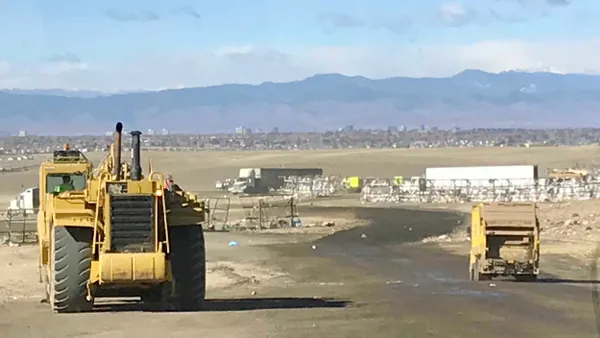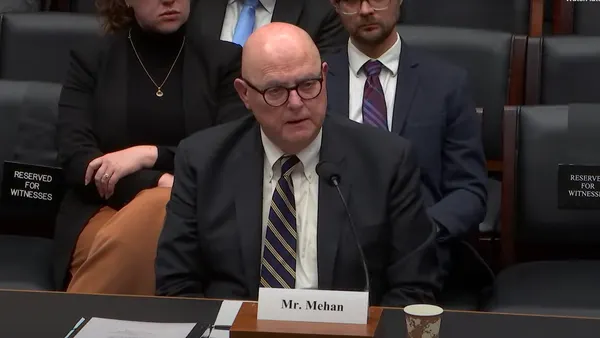Dive Brief:
-
The U.S. Environmental Protection Agency on Friday issued a final rule expanding the lining standards for coal ash ponds.
-
Coal-fired power plants must meet certain standards in order for their coal ash ponds to be considered "lined" under the 2015 federal coal combustion residuals (CCR) rule. A 2018 decision from the U.S. Court of Appeals for the D.C. Circuit found those requirements weren't stringent enough, and ruled that clay-lined ponds should be considered "unlined" because they were proven by evidence accumulated by EPA to be less effective than plastic-lined basins. But Friday's rule from the EPA will allow some facilities to prove non-plastic lining is just as protective of the environment.
-
Environmentalists criticized the rule, saying it violates the D.C. Circuit's ruling, and is therefore illegal. But the power industry says the rule is based on a record EPA has built since 2015, and will apply to only a narrow subset of facilities.
Dive Insight:
CCR rules were set under the Obama administration in response to major coal ash spills in Tennessee and North Carolina that contaminated local waterways. Environmentalists said the 2015 rules were not protective enough, while industry groups argued the regulations went too far.
Under President Donald Trump's deregulatory agenda, the EPA has taken a number of steps to relax the 2015 rules. In July, the agency finalized Part A of its regulation, giving some facilities more time to close unlined coal ash ponds. Part B of the rule, finalized last week, broadens the definition of which ponds are considered lined.
Under the 2015 rule, all new coal ash facilities are required to build composite-lined ponds to store the ash, but the rule allowed unlined or clay-lined facilities to continue operating. Composite lining constitutes at least two feet of compact soil surrounded by a plastic coating. That method is the most effective way to protect groundwater, according to the record established by the EPA and laid out by the D.C. Circuit, but only 17% of the country's 735 active surface impoundments are composite-lined.
Some 65% of surface impoundments are unlined, while the remaining ponds are "lined only with compacted soil or other partial or high-permeability liners," according to the D.C. Circuit's findings. According to the EPA's record presented to the court, unlined facilities have a 36.2% to 57% chance of leakage at a harmful contaminating level during their "foreseeable use," versus a 0.1% chance of contamination from composite-lined basins.
Therefore, according to the D.C. Circuit's ruling, the only ponds that can legally be considered "lined" are ponds with composite lining, and all unlined ponds must close. But the EPA's final rule says facilities can make the case for "alternative" lining, subject to approval by the EPA only if that lining is at least as protective as composite lining.
For example, if a utility company is operating a pond surrounded by 10 feet or more of compact clay, that facility would likely be more effective at preventing groundwater leakage than a composite facility, according to Jim Roewer, executive director of the Utility Solid Waste Activities Group (USWAG), a trade group that represents waste issues on behalf of U.S. utility companies. EPA says the move gives industry more flexibility, while continuing to protect the environment.
This allowance will apply to a "handful" of facilities, Roewer said. "This is not an industry-wide phenomenon," he said. It's unclear how much money this rule might save industry as a result of its likely narrow application.
And although the D.C. Circuit narrowed the definition of what constitutes a lined facility to include only composite-lined ponds, that ruling is based on the EPA's record through 2015, a record that has since expanded to prove that some lining can be as protective as the composite requirements, said Roewer. He disputes the notion that the agency's rule change will allow further pollution.
"It's not true that unsafe units will be able to continue to pollute," he said. "You can't walk away from that responsibility ... Industry has no intention to ignore any groundwater contamination that might be there."
But environmental groups say the D.C. Circuit was very specific — it asked the EPA to "strengthen, not weaken" the 2015 rule. Ultimately, this rule will allow facilities under review to stay open longer, rather than closing immediately for being unlined, according to Earthjustice. Combined with Part A of the rule, which allows unlined ponds to continue operating until April 2021, these rules could allow an unknown number of ponds across the country to continue taking in coal ash while not meeting federal safety standards.
"The administration's announcement opens the door to keeping some coal ponds open indefinitely that a court found should be closed to protect health, the environment and drinking water. I've never seen an administration so willing to repeatedly violate a court order directing the EPA to protect the public's health and the environment," Lisa Evans, senior counsel at Earthjustice, said in a statement.










